Samsung NX 18-55 mm f/3.5-5.6 OIS
3. Build quality and image stabilization
First it was difficult not to compare the tested lens with another “kit” device belonging to a mirrorless system with an APS-C sensor so the Sony E 18–55ámm f/3.5–5.6 OSS. It is slightly shorter and weighs practically the same. Even though it has one optical element less it features as many as three aspherical ones. At first glance, though, the Sony seems to be bigger, especially when attached to the Sony NEX-5 camera which is smaller than the Samsung NX10. Also the Panasonic G VARIO 14-42 mm f/3.5-5.6 ASPH MEGA O.I.S. of the Micro Four Thirds system is very similar to the Samsung “kit” (appearances and dimensions-wise). Only the Olympus instrument sticks out among this lot because of its diminutive size but you must remember the specifications are given for the device in its transport position. In the working position the Olympus “kit” must be unlocked and its dimensions increase.
The Samsung NX 18–55ámm f/3.5–5.6 OIS is physically the lightest and the smallest of all but the biggest difference can be spotted if you compare it with Canon and Nikon “kits”. One more thing is worth our notice – among all lenses, compared here, it is exactly the tested Samsung which offers the smallest mapping scale, definitely too small to think seriously about any macro photography.
Please Support UsIf you enjoy our reviews and articles, and you want us to continue our work please, support our website by donating through PayPal. The funds are going to be used for paying our editorial team, renting servers, and equipping our testing studio; only that way we will be able to continue providing you interesting content for free. |
- - - - - - - - - - - - - - - - - - - - - - - - - - - - - - - - - - - - - - - - - - - - - - - -
The photo below shows the Samsung NX 18–55ámm f/3.5–5.6 OIS positioned next to its system brothers – the Samsung NX 20–50ámm f/3.5–5.6 and the Samsung NX 30ámm f/2
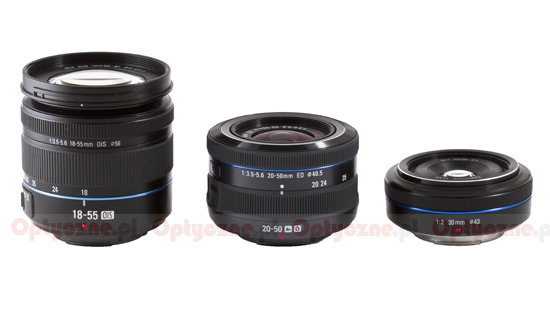 |
As we mentioned above, first mirrorless devices produced by Samsung were designed in the convention of a “small reflex camera”. That’s why the set of the Samsung NX10 and the NX 18-55 mm f/3.5-5.6 OIS looks like that and relatively big dimensions of the lens don’t offend your eyes as much as those of the Sony NEX-5 and the Sony E 18–55ámm f/3.5–5.6 OSS tandem. The lens gets a lot longer during work so the disproportions between the lens and the body are even more pronounced. Below we present the pictures of the standard Samsung set.
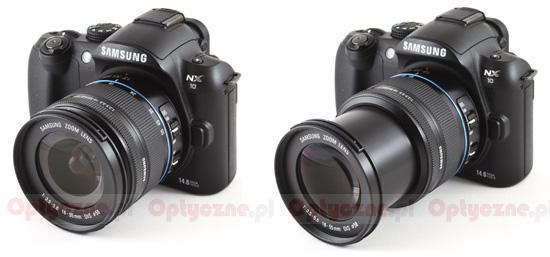 |
Still the lens becomes relatively bigger attached to the NX100, presented not so long ago, and the situation known in the case of the Sony NEX system is repeated here. That’s why with the launch of the NX100 a smaller, more compact version of the kit lens - the Samsung NX 20-50 mm f/3.5-5.6- was presented as well.
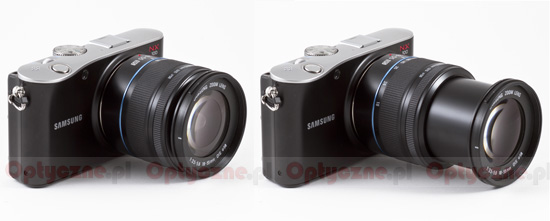 |
Although the lens is made of plastics from the very beginning we have been impressed by its build quality. When you hold it in your hand you notice attention to detail. Everything fits well, there are no slacks. Some reservations can be expressed when it comes to an uneven work of the zoom ring. In the range from 18 to ca.30 mm it moves smoothly but afterwards you feel a distinct resistance. The focus ring turns very smoothly and is well-damped for a change. After the lens was used in a normal way for several weeks no scratches appeared on it.
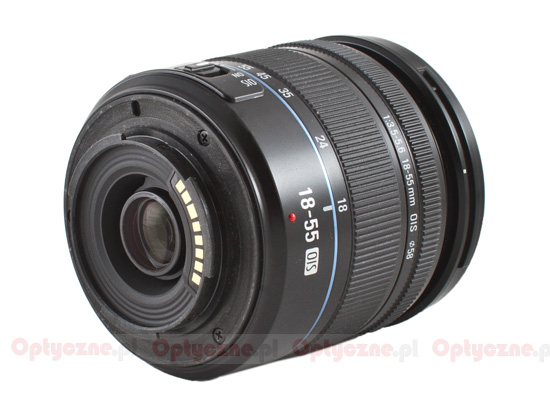 |
The lens starts with a plastic mount in which is hidden an element with a diameter of 14 mm. When the focal length increases it hides quite deeply inside the barrel. On the first immobile part you can find a red mark indicating the right housing, the marking of the lens, stabilization and autofocus switches.
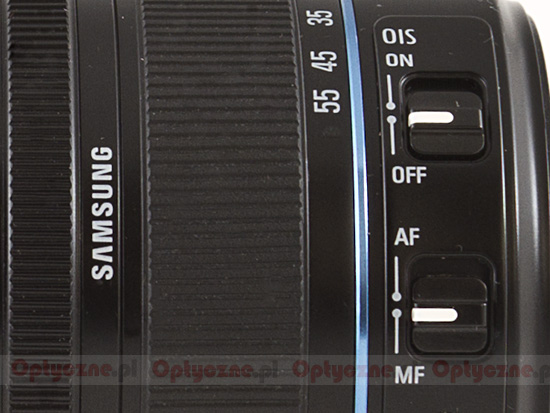 |
The ribbed zoom ring is 2 cm wide and there is a distance scale on it with the values of 18, 24, 35, 45 and 55ámm. Behind that ring you see one more immobile ring 3 mm wide with the lens’s parameters and the producer’s logo on it. The main part of the lens ends with a quite narrow (6 mm) ribbed focus ring. The lens is topped with an inner tube which length depends on the focal length – it is totally collapsed at 18 mm and at 55 mm it is extended by 3.2 cm. At the end of the inner tube you can find a front element 4 cm in diameter and a non-rotating filter thread, 58 mm in diameter.
When it comes to the inner design the lens consists of 12 elements positioned in 9 groups. There’s one aspherical element among them and a circular aperture with 7 diaphragm blades which can be closed down to f/22.
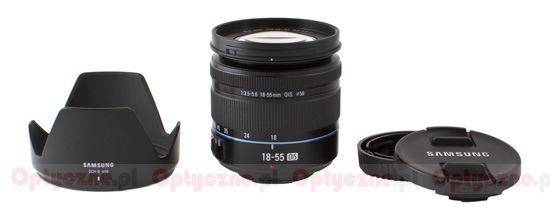 |
If you buy the Samsung NX 18–55ámm f/3.5–5.6 OIS you will also get a lens hood and two caps included in box.
Stabilization
The lack of sensor stabilization in Samsung NX cameras means this system’s lens must be stabilized instead. The “kit”, being theoretically the most popular tool here, was an obvious choice. Let’s check how the stabilization module, used here, works in practice. According to our standard procedure we took photos at the equivalent of about 50 mm focal length at different exposure times and we compared the number of blurred photos for the stabilization switched on and off. The appropriate graph is presented below. The exposure time is expressed in exposure values and in this case 0 EV equals the time of 1/80 of a second.
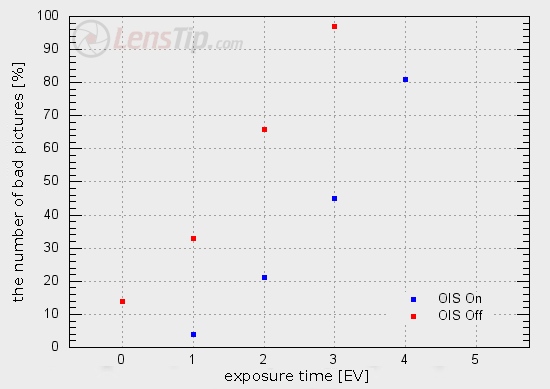
Unfortunately the stabilization efficiency, shown here, doesn’t impress as it amounts only to about 1-1.5 EV. It’s low for contemporary standards – the stabilization seems to be just an insignificant addition, not a fully-fledged equivalent of the sensor’s stabilization. The graph above presents the performance of Mode 1 stabilization (chosen on the level of the camera’s menu) which is switched on only when you take a photo. The Mode 2, so the stabilization switched on all the time, gives results by additional 0.5 EV better.






